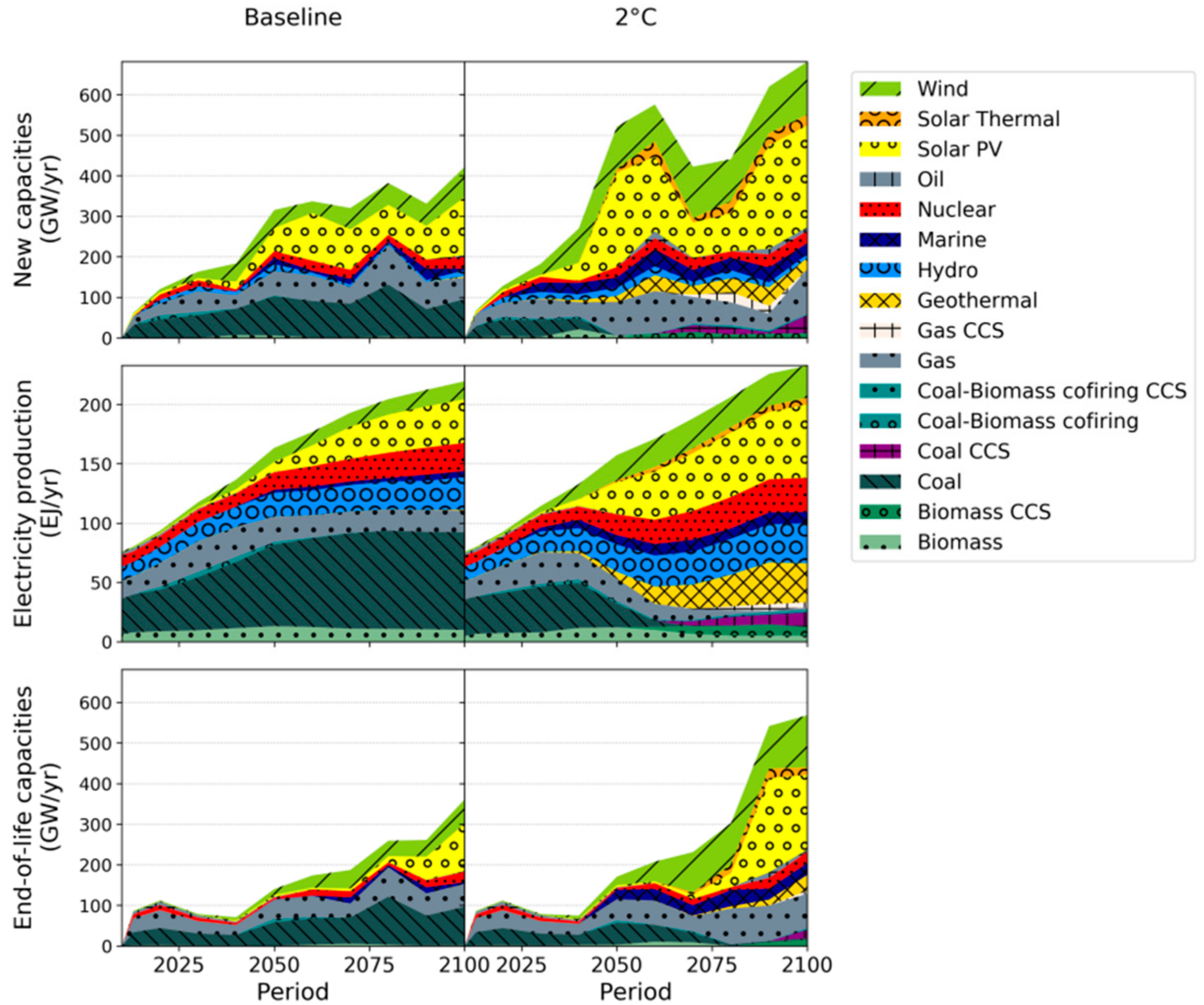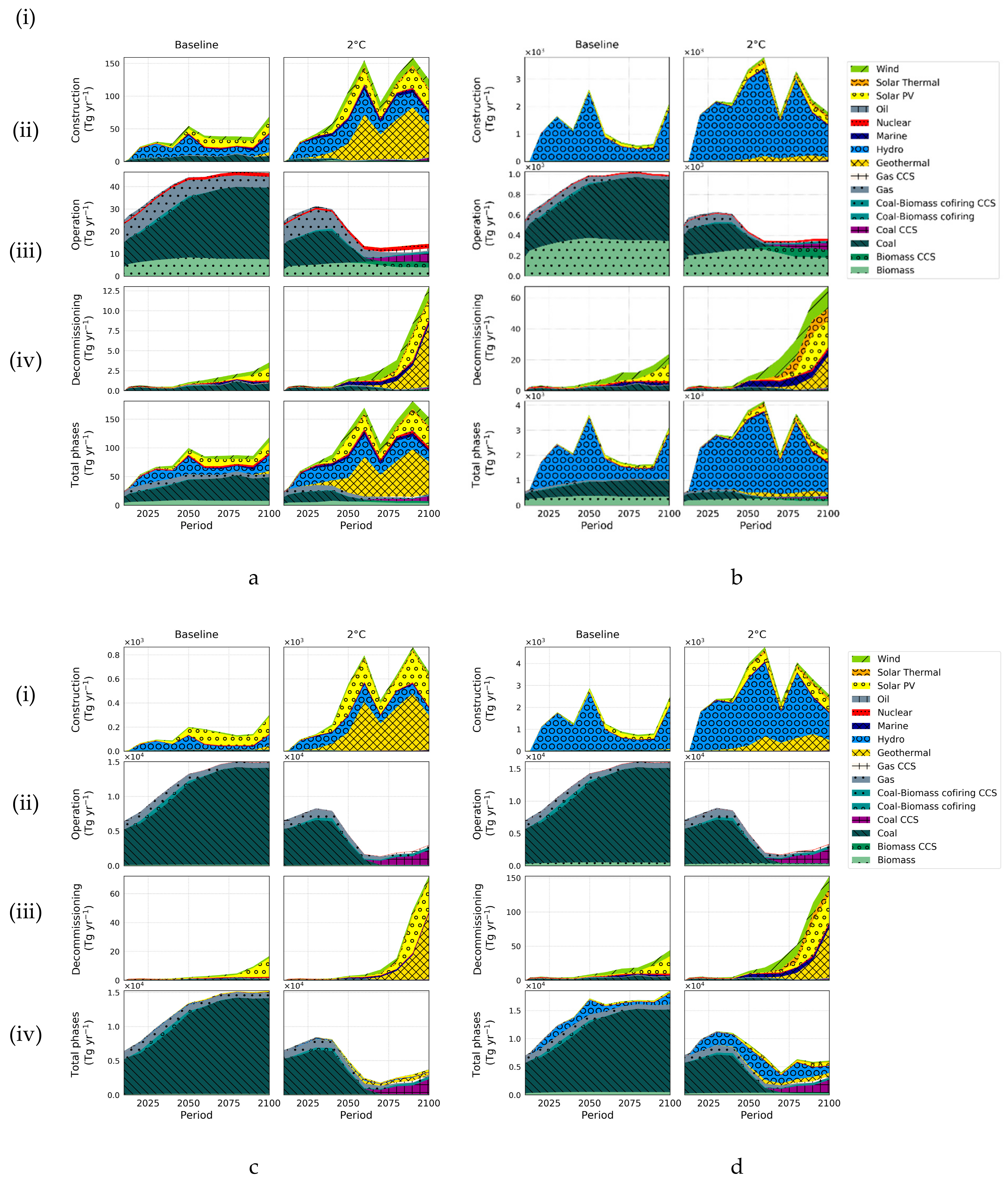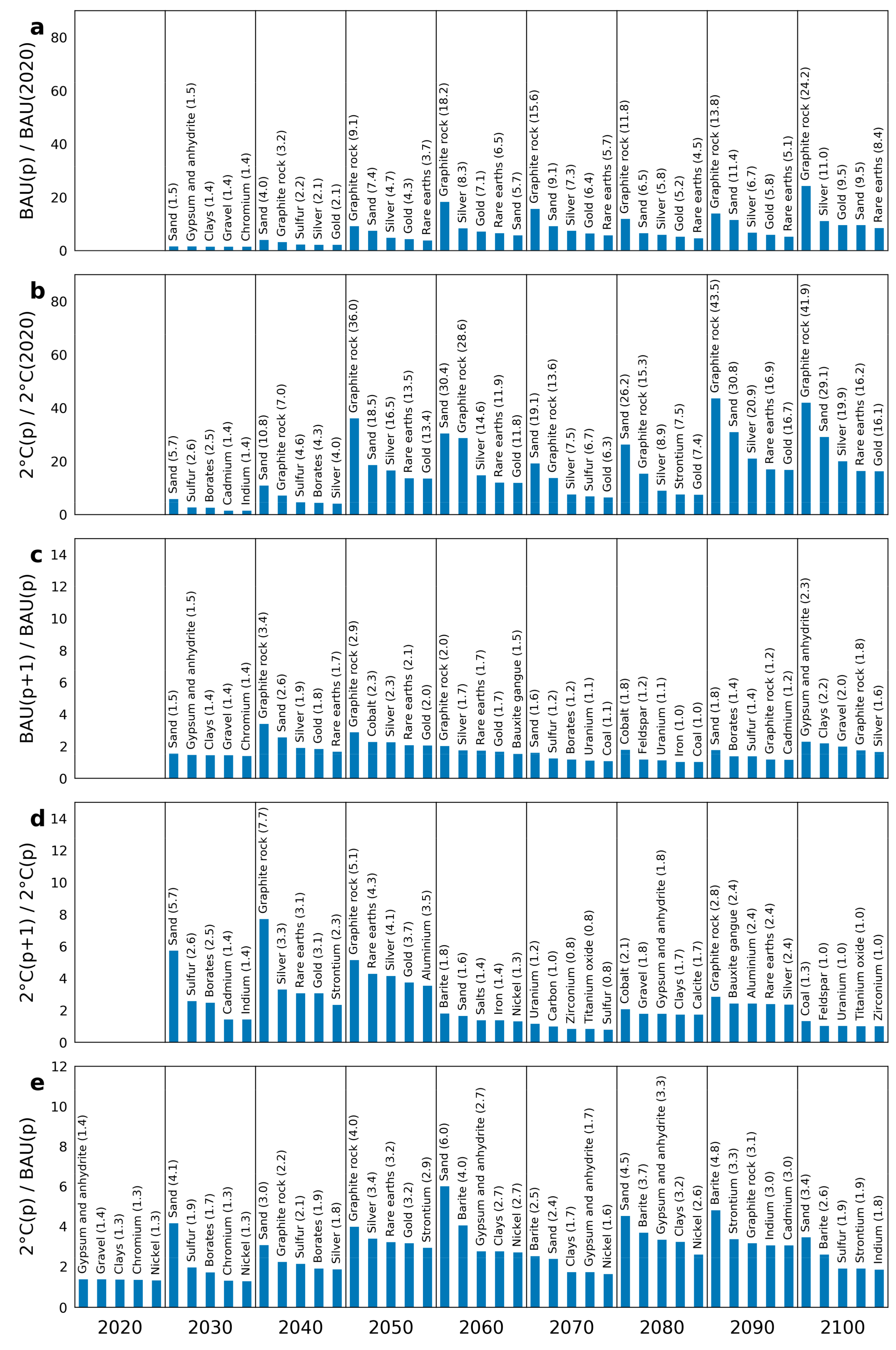Devising Mineral Resource Supply Pathways to a Low-Carbon Electricity Generation by 2100
Abstract
1. Introduction
2. Method
2.1. TIAM-FR Model
2.2. Linking Electricity Outputs with Life-Cycle Inventories
3. Results
3.1. Global Electricity Generation
3.2. Raw Material Footprint of Electricity-Generating Technologies
3.3. Most-Impacted Substances
3.4. The 2 °C Target
4. Discussion and Path Forward
4.1. Static vs. Evolutionary LCIs
4.2. Resource Depletion and Footprint
4.3. Other Energy Sectors
4.4. Towards Simpler and More Complex Models
4.5. Shared Socioeconomic (Metabolism) Pathways
Supplementary Materials
Author Contributions
Funding
Acknowledgments
Conflicts of Interest
References
- Edenhofer, O. Climate Change 2014: Mitigation of Climate Change; Working Group III contribution to the Fifth Assessment Report of the Intergovernmental Panel on Climate Change; Cambridge University Press: New York, NY, USA, 2014; ISBN 978-1-107-05821-7. [Google Scholar]
- Semertzidis, T. Can Energy Systems Models Address the Resource Nexus? Energy Procedia 2015, 83, 279–288. [Google Scholar] [CrossRef]
- Pauliuk, S.; Arvesen, A.; Stadler, K.; Hertwich, E.G. Industrial ecology in integrated assessment models. Nat. Clim. Change 2017, 7, 13–20. [Google Scholar] [CrossRef]
- Van der Voet, E. Environmental Risks and Challenges of Anthropogenic Metals Flows and Cycles; Report 3; Working Group on the Global Metal Flows, Ed.; United Nations Environment Programme: Nairobi, Kenya, 2013; ISBN 978-92-807-3266-5. [Google Scholar]
- Van Vuuren, D.P.; Strengers, B.J.; De Vries, H.J. Long-term perspectives on world metal use—A system-dynamics model. Resour. Policy 1999, 25, 239–255. [Google Scholar] [CrossRef]
- Rohstoffe für Zukunftstechnologien: Einfluss des Branchenspezifischen Rohstoffbedarfs in Rohstoffintensiven Zukunftstechnologien auf die Zukünftige Rohstoffnachfrage. ISI-Schriftenreihe Innovationspotenziale; 2., überarb. Aufl; Angerer, G., Erdmann, L., Marscheider-Weidemann, F., Scharp, M., Lüllmann, A., Fraunhofer-Institut für System- und Innovationsforschung, Eds.; Fraunhofer Verl: Stuttgart, Germany, 2009; ISBN 978-3-8396-0014-6. [Google Scholar]
- Moss, R.; Tzimas, E.; Kara, H.; Willis, P.; Kooroshy, J. Critical Metals in Strategic Energy Technologies-Assessing Rare Metals as Supply-Chain Bottlenecks in Low-Carbon Energy Technologies; European Commission: Brussels, Belgium, 2012. [Google Scholar]
- Espinoza, L.A.T. The Role of Emerging Technologies in Rapidly Changing Demand for Mineral Raw Material; POLINARES Working Paper n. 27; European Commission: Brussels, Belgium, 2012. [Google Scholar]
- Elshkaki, A.; Graedel, T.E. Dynamic analysis of the global metals flows and stocks in electricity generation technologies. J. Clean. Prod. 2013, 59, 260–273. [Google Scholar] [CrossRef]
- Hoenderdaal, S.; Tercero Espinoza, L.; Marscheider-Weidemann, F.; Graus, W. Can a dysprosium shortage threaten green energy technologies? Energy 2013, 49, 344–355. [Google Scholar] [CrossRef]
- Stamp, A.; Wäger, P.A.; Hellweg, S. Linking energy scenarios with metal demand modeling–The case of indium in CIGS solar cells. Resour. Conserv. Recycl. 2014, 93, 156–167. [Google Scholar] [CrossRef]
- Habib, K.; Wenzel, H. Exploring rare earths supply constraints for the emerging clean energy technologies and the role of recycling. J. Clean. Prod. 2014, 84, 348–359. [Google Scholar] [CrossRef]
- Grandell, L.; Lehtilä, A.; Kivinen, M.; Koljonen, T.; Kihlman, S.; Lauri, L.S. Role of critical metals in the future markets of clean energy technologies. Renew. Energy 2016, 95, 53–62. [Google Scholar] [CrossRef]
- Elshkaki, A.; Graedel, T.E.; Ciacci, L.; Reck, B.K. Resource Demand Scenarios for the Major Metals. Environ. Sci. Technol. 2018, 52, 2491–2497. [Google Scholar] [CrossRef]
- Deetman, S.; Pauliuk, S.; van Vuuren, D.P.; van der Voet, E.; Tukker, A. Scenarios for Demand Growth of Metals in Electricity Generation Technologies, Cars, and Electronic Appliances. Environ. Sci. Technol. 2018, 52, 4950–4959. [Google Scholar] [CrossRef]
- Kleijn, R.; van der Voet, E.; Kramer, G.J.; van Oers, L.; van der Giesen, C. Metal requirements of low-carbon power generation. Energy 2011, 36, 5640–5648. [Google Scholar] [CrossRef]
- De Koning, A.; Kleijn, R.; Huppes, G.; Sprecher, B.; van Engelen, G.; Tukker, A. Metal supply constraints for a low-carbon economy? Resour. Conserv. Recycl. 2018, 129, 202–208. [Google Scholar] [CrossRef]
- Hertwich, E.G.; Gibon, T.; Bouman, E.A.; Arvesen, A.; Suh, S.; Heath, G.A.; Bergesen, J.D.; Ramirez, A.; Vega, M.I.; Shi, L. Integrated life-cycle assessment of electricity-supply scenarios confirms global environmental benefit of low-carbon technologies. Proc. Natl. Acad. Sci. USA 2015, 112, 6277–6282. [Google Scholar] [CrossRef] [PubMed]
- Boubault, A.; Kang, S.; Maïzi, N. Closing the TIMES Integrated Assessment Model (TIAM-FR) Raw Materials Gap with Life Cycle Inventories: Integrated Assessment Using Life Cycle Inventories. J. Ind. Ecol. 2018, in press. [Google Scholar] [CrossRef]
- O’Neill, B.C.; Kriegler, E.; Riahi, K.; Ebi, K.L.; Hallegatte, S.; Carter, T.R.; Mathur, R.; van Vuuren, D.P. A new scenario framework for climate change research: The concept of shared socioeconomic pathways. Clim. Change 2014, 122, 387–400. [Google Scholar] [CrossRef]
- Loulou, R.; Labriet, M. ETSAP-TIAM: The TIMES integrated assessment model Part I: Model structure. Comput. Manag. Sci. 2008, 5, 7–40. [Google Scholar] [CrossRef]
- Loulou, R. ETSAP-TIAM: The TIMES integrated assessment model. Part II: Mathematical formulation. Comput. Manag. Sci. 2008, 5, 41–66. [Google Scholar] [CrossRef]
- Energy Technology Systems Analysis Program E-TechDS–Energy Technology Data Source. Available online: https://iea-etsap.org/index.php/energy-technology-data (accessed on 31 March 2018).
- Selosse, S.; Ricci, O. Achieving negative emissions with BECCS (bioenergy with carbon capture and storage) in the power sector: New insights from the TIAM-FR (TIMES Integrated Assessment Model France) model. Energy 2014, 76, 967–975. [Google Scholar] [CrossRef]
- Dubreuil, A.; Assoumou, E.; Bouckaert, S.; Selosse, S.; Maıïzi, N. Water modeling in an energy optimization framework–The water-scarce middle east context. Appl. Energy 2013, 101, 268–279. [Google Scholar] [CrossRef]
- Kang, S.; Selosse, S.; Maïzi, N. Strategy of bioenergy development in the largest energy consumers of Asia (China, India, Japan and South Korea). Energy Strategy Rev. 2015, 8, 56–65. [Google Scholar] [CrossRef]
- Kang, S.; Selosse, S.; Maïzi, N. Is GHG mitigation policy enough to develop bioenergy in Asia: A long-term analysis with TIAM-FR. Int. J. Oil Gas Coal Technol. 2017, 14, 5–31. [Google Scholar] [CrossRef]
- Fricko, O.; Havlik, P.; Rogelj, J.; Klimont, Z.; Gusti, M.; Johnson, N.; Kolp, P.; Strubegger, M.; Valin, H.; Amann, M.; et al. The marker quantification of the Shared Socioeconomic Pathway 2: A middle-of-the-road scenario for the 21st century. Glob. Environ. Change 2017, 42, 251–267. [Google Scholar] [CrossRef]
- Riahi, K.; van Vuuren, D.P.; Kriegler, E.; Edmonds, J.; O’Neill, B.C.; Fujimori, S.; Bauer, N.; Calvin, K.; Dellink, R.; Fricko, O.; et al. The Shared Socioeconomic Pathways and their energy, land use, and greenhouse gas emissions implications: An overview. Glob. Environ. Change 2017, 42, 153–168. [Google Scholar] [CrossRef]
- Bruckner, T.; Bashmakov, I.A.; Mulugetta, Y.; Chum, H.; de la Vega Navarro, A.; Edmonds, J.; Faaij, A.; Fungtammasan, B.; Garg, A.; Hertwich, E.; Honnery, D.; Infield, D.; Kainuma, M.; Khennas, S.; Kim, S.; Nimir, H.B.; Riahi, K.; Strachan, N.; Wiser, R.; Zhang, X. Energy Systems. In Climate Change 2014: Mitigation of Climate Change. Contribution of Working Group III to the Fifth Assessment Report of the Intergovernmental Panel on Climate Change; Edenhofer, O., Pichs-Madruga, R., Sokona, Y., Farahani, E., Kadner, S., Seyboth, K., Adler, A., Baum, I., Brunner, S., Eickemeier, P., Kriemann, B., Savolainen, J., Schlömer, S., von Stechow, C., Zwickel, T., Minx, J.C., Eds.; Cambridge University Press: Cambridge, UK; New York, NY, USA, 2014. [Google Scholar]
- Gerst, M.D. Linking Material Flow Analysis and Resource Policy via Future Scenarios of In-Use Stock: An Example for Copper. Environ. Sci. Technol. 2009, 43, 6320–6325. [Google Scholar] [CrossRef] [PubMed]
- Nassar, N.T.; Barr, R.; Browning, M.; Diao, Z.; Friedlander, E.; Harper, E.M.; Henly, C.; Kavlak, G.; Kwatra, S.; Jun, C.; et al. Criticality of the Geological Copper Family. Environ. Sci. Technol. 2012, 46, 1071–1078. [Google Scholar] [CrossRef] [PubMed]
- Harmsen, J.H.M.; Roes, A.L.; Patel, M.K. The impact of copper scarcity on the efficiency of 2050 global renewable energy scenarios. Energy 2013, 50, 62–73. [Google Scholar] [CrossRef]
- Tokimatsu, K.; Wachtmeister, H.; McLellan, B.; Davidsson, S.; Murakami, S.; Höök, M.; Yasuoka, R.; Nishio, M. Energy modeling approach to the global energy-mineral nexus: A first look at metal requirements and the 2 °C target. Appl. Energy 2017, 207, 494–509. [Google Scholar] [CrossRef]
- Herrington, R. Road map to mineral supply. Nat. Geosci. 2013, 6, 892–894. [Google Scholar] [CrossRef]
- European Commission. Raw Materials Supply Group Study on the Review of the List of Critical Raw Materials; European Commission: Brussels, Belgium, 2017; p. 93. [Google Scholar]
- Rabe, W.; Kostka, G.; Smith Stegen, K. China’s supply of critical raw materials: Risks for Europe’s solar and wind industries? Energy Policy 2017, 101, 692–699. [Google Scholar] [CrossRef]
- Sprecher, B.; Reemeyer, L.; Alonso, E.; Kuipers, K.; Graedel, T.E. How “black swan” disruptions impact minor metals. Resour. Policy 2017, 54, 88–96. [Google Scholar] [CrossRef]
- United Nations Environment Programme. United Nations Environment Programme Decoupling Natural Resource Use and Environmental Impacts from Economic Growth; OCLC: 838605225; United Nations Environment Programme: Kenya, Africa, 2011.
- Prior, T.; Giurco, D.; Mudd, G.; Mason, L.; Behrisch, J. Resource depletion, peak minerals and the implications for sustainable resource management. Glob. Environ. Change 2012, 22, 577–587. [Google Scholar] [CrossRef]
- Mudd, G.M. The Sustainability of Mining in Australia: Key Production Trends and Environmental Implications; Monash University: Melbourne, Australia, 2009. [Google Scholar]
- Pehl, M.; Arvesen, A.; Humpenöder, F.; Popp, A.; Hertwich, E.G.; Luderer, G. Understanding future emissions from low-carbon power systems by integration of life-cycle assessment and integrated energy modelling. Nat. Energy 2017, 2, 939–945. [Google Scholar] [CrossRef]
- Christmann, P. Towards a More Equitable Use of Mineral Resources. Nat. Resour. Res. 2017, 27, 159–177. [Google Scholar] [CrossRef]
- Font Vivanco, D.; Kemp, R.; van der Voet, E. How to deal with the rebound effect? A policy-oriented approach. Energy Policy 2016, 94, 114–125. [Google Scholar] [CrossRef]
- Guinée, J. Life Cycle Sustainability Assessment: What Is It and What Are Its Challenges? In Taking Stock of Industrial Ecology; Clift, R., Druckman, A., Eds.; Springer International Publishing: Berlin, Germany, 2016; pp. 45–68. ISBN 978-3-319-20571-7. [Google Scholar]
- Habib, K.; Wenzel, H. Reviewing resource criticality assessment from a dynamic and technology specific perspective—Using the case of direct-drive wind turbines. J. Clean. Prod. 2016, 112, 3852–3863. [Google Scholar] [CrossRef]
- Pauliuk, S.; Majeau-Bettez, G.; Müller, D.B. A General System Structure and Accounting Framework for Socioeconomic Metabolism: General System Structure for Society’s Metabolism. J. Ind. Ecol. 2015, 19, 728–741. [Google Scholar] [CrossRef]
- Fischer-Kowalski, M.; Haberl, H. Sustainable development: Socio-economic metabolism and colonization of nature. Int. Soc. Sci. J. 1998, 50, 573–587. [Google Scholar] [CrossRef]
- England, J.L. Dissipative adaptation in driven self-assembly. Nat. Nanotechnol. 2015, 10, 919–923. [Google Scholar] [CrossRef]



© 2019 by the authors. Licensee MDPI, Basel, Switzerland. This article is an open access article distributed under the terms and conditions of the Creative Commons Attribution (CC BY) license (http://creativecommons.org/licenses/by/4.0/).
Share and Cite
Boubault, A.; Maïzi, N. Devising Mineral Resource Supply Pathways to a Low-Carbon Electricity Generation by 2100. Resources 2019, 8, 33. https://doi.org/10.3390/resources8010033
Boubault A, Maïzi N. Devising Mineral Resource Supply Pathways to a Low-Carbon Electricity Generation by 2100. Resources. 2019; 8(1):33. https://doi.org/10.3390/resources8010033
Chicago/Turabian StyleBoubault, Antoine, and Nadia Maïzi. 2019. "Devising Mineral Resource Supply Pathways to a Low-Carbon Electricity Generation by 2100" Resources 8, no. 1: 33. https://doi.org/10.3390/resources8010033
APA StyleBoubault, A., & Maïzi, N. (2019). Devising Mineral Resource Supply Pathways to a Low-Carbon Electricity Generation by 2100. Resources, 8(1), 33. https://doi.org/10.3390/resources8010033



